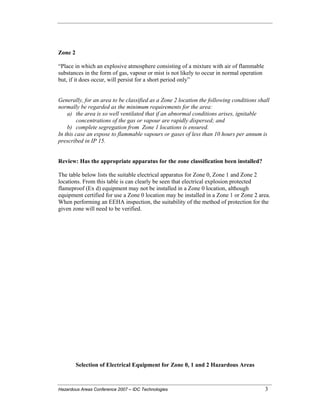The 5-Minute Rule for Roar Solutions
The 5-Minute Rule for Roar Solutions
Blog Article
The Buzz on Roar Solutions
Table of ContentsLittle Known Facts About Roar Solutions.The Basic Principles Of Roar Solutions An Unbiased View of Roar Solutions
In such an environment a fire or explosion is feasible when 3 basic conditions are satisfied. This is usually described as the "hazardous area" or "burning" triangle. In order to secure installations from a potential explosion an approach of evaluating and classifying a possibly unsafe area is called for. The function of this is to guarantee the proper option and setup of equipment to ultimately protect against a surge and to make sure safety of life.
(https://sandbox.zenodo.org/records/174151)
No devices should be mounted where the surface area temperature level of the tools is more than the ignition temperature level of the offered danger. Below are some usual dirt dangerous and their minimum ignition temperature level. Coal Dust 380C 225C Polythene 420C (thaws) Methyl Cellulose 420C 320C Starch 460C 435C Flour 490C 340C Sugar 490C 460C Grain Dirt 510C 300C Phenolic Material 530C > 450C Aluminium 590C > 450C PVC 700C > 450C Soot 810C 570C The chance of the hazard being present in a concentration high sufficient to create an ignition will differ from area to place.
Harmful location electrical devices possibly made for usage in higher ambient temperatures. Field Repair Service By Authorised Employee: Complex screening may not be needed nonetheless certain treatments may require to be adhered to in order for the tools to maintain its third event ranking. Each piece of devices with a hazardous ranking need to be evaluated independently.
A Biased View of Roar Solutions
The tools register is a thorough data source of equipment records that consists of a minimum collection of fields to determine each item's area, technological parameters, Ex-spouse classification, age, and environmental data. The proportion of Thorough to Close assessments will be established by the Devices Danger, which is analyzed based on ignition danger (the chance of a source of ignition versus the possibility of a combustible atmosphere )and the hazardous area category
( Zone 0, 1, or 2). Executing a durable Risk-Based Examination( RBI )strategy is vital for guaranteeing compliance and safety and security in managing Electrical Devices in Hazardous Locations( EEHA).
The smart Trick of Roar Solutions That Nobody is Talking About

In terms of explosive risk, a hazardous area is an environment in which an eruptive environment exists (or may be anticipated to be existing) in amounts that call for special safety measures for the building, installment and use of tools. electrical refresher course. In this post we check out the challenges faced in the office, the threat control actions, and the required proficiencies to function safely
It issues of modern-day life that we produce, save or deal with a variety of gases or liquids that are regarded flammable, and a variety of dirts that are deemed combustible. These compounds can, in specific problems, create eruptive ambiences and these can have significant and heartbreaking effects. The majority of us are familiar with the fire triangle eliminate any kind of among the 3 components and the fire can not take place, but what does this mean in the context of harmful locations? When breaking this down right into its easiest terms it is essentially: a combination of a specific amount of release or leak of a certain substance or product, combining with ambient oxygen, and the presence of a source of ignition.
In many instances, we can do little concerning the degrees of oxygen airborne, however we can have considerable impact on sources of ignition, for example electrical tools. Dangerous areas are recorded on the hazardous location classification illustration and are determined on-site by the triangular "EX LOVER" sign. Below, amongst other key information, visit the site areas are split into three types relying on the hazard, the chance and period that an eruptive atmosphere will certainly exist; Zone 0 or 20 is regarded one of the most hazardous and Zone 2 or 22 is regarded the least.
Report this page